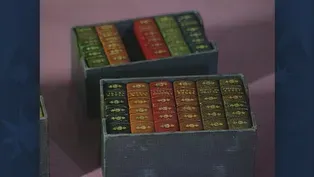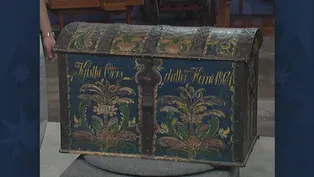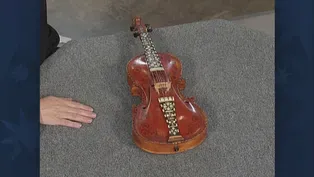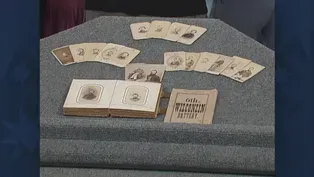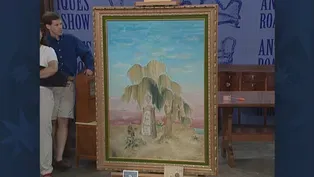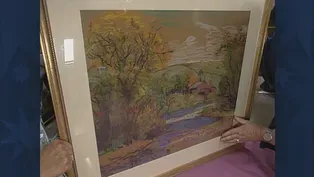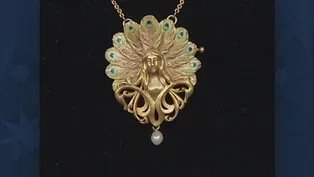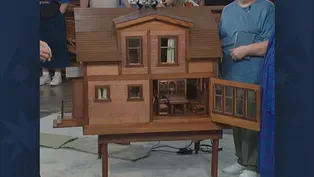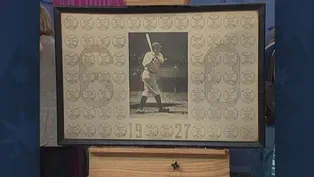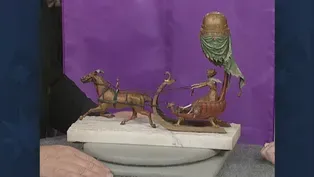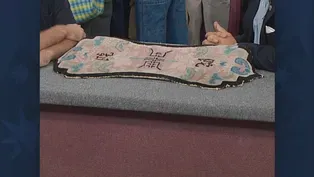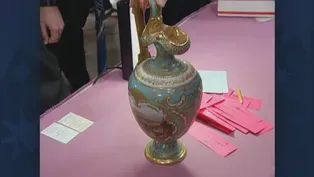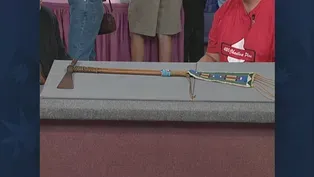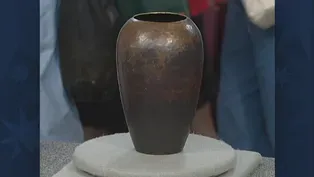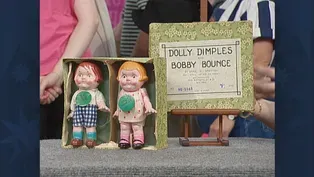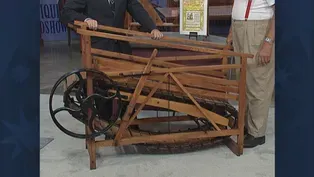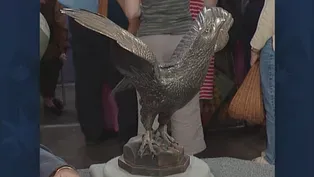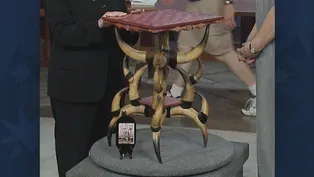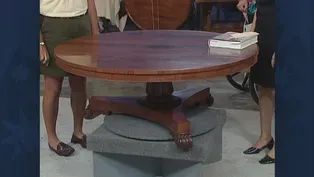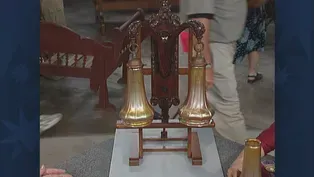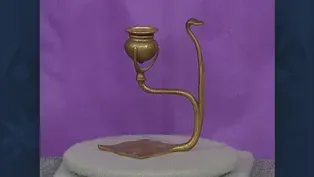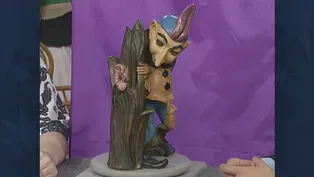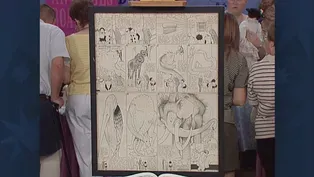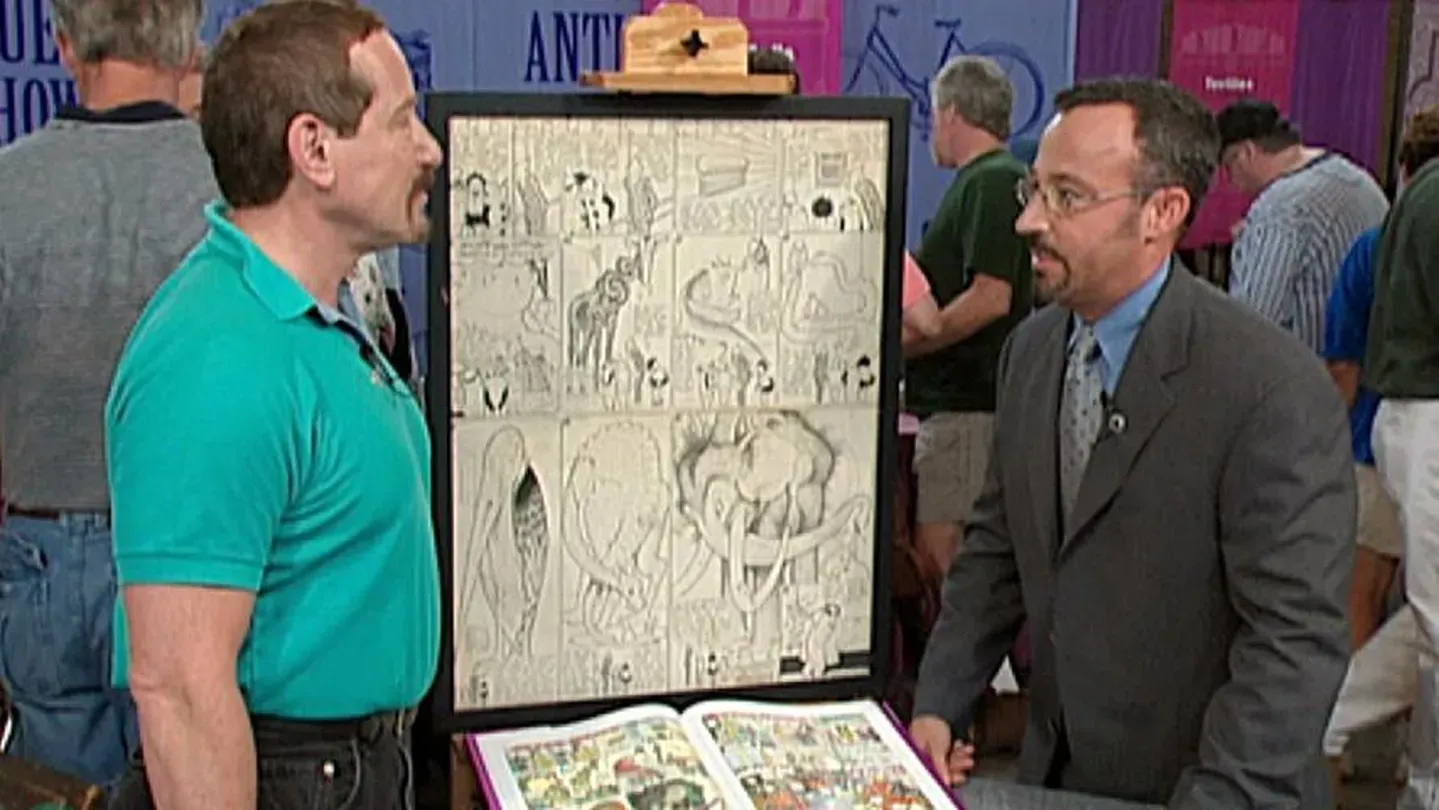

Vintage Madison
Season 19 Episode 30 | 53m 9sVideo has Closed Captions
Journey back 15 years and learn how items hold up today, plus an $80,000-$100,000 find.
Journey back 15 years and learn how fantastic finds have fared in today’s market. Highlights include an 1875 Norwegian Hardanger fiddle, Winsor McCay comic art, and an Eanger Irving Couse oil. Uncover which item doubled in value to $80,000-$100,000.
Problems with Closed Captions? Closed Captioning Feedback
Problems with Closed Captions? Closed Captioning Feedback
Funding for ANTIQUES ROADSHOW is provided by Ancestry and American Cruise Lines. Additional funding is provided by public television viewers.

Vintage Madison
Season 19 Episode 30 | 53m 9sVideo has Closed Captions
Journey back 15 years and learn how fantastic finds have fared in today’s market. Highlights include an 1875 Norwegian Hardanger fiddle, Winsor McCay comic art, and an Eanger Irving Couse oil. Uncover which item doubled in value to $80,000-$100,000.
Problems with Closed Captions? Closed Captioning Feedback
How to Watch Antiques Roadshow
Antiques Roadshow is available to stream on pbs.org and the free PBS App, available on iPhone, Apple TV, Android TV, Android smartphones, Amazon Fire TV, Amazon Fire Tablet, Roku, Samsung Smart TV, and Vizio.
Buy Now

ANTIQUES ROADSHOW 2025 Tour!
Enter now for a chance to win free tickets to ANTIQUES ROADSHOW's 2025 Tour! Plus, see which cities we're headed to!Providing Support for PBS.org
Learn Moreabout PBS online sponsorshipOkay, I have a few surprises for you.
APPRAISER: This piece should be in a museum.
It's that important.
Oh, my goodness.
APPRAISER: He's a prize, and you had great foresight to buy him.
Didn't dream he was worth that much.
APPRAISER: This is by Tiffany Studios.
WOMAN (laughing): I'm really surprised.
I had no clue.
It's lucky I didn't sell it at a garage sale.
MARK WALBERG: We visited Wisconsin's capital, Madison, for the first time in 2000.
This four-lake city was overflowing with interesting art and antiques all day long.
How do the values of some of those treasures fare 15 years later?
Find out now in this fresh look at Madison.
APPRAISER: It looks like a violin, but it has eight strings.
This is a Hardanger fiddle.
It's a Norwegian folk fiddle.
Now, how do you happen to have a Hardanger fiddle?
It came to my brother from his uncle, who got it from his uncle, and they were English but they lived in a Norwegian community in the center part of the state.
These were prized possessions of the Norwegians that emigrated to this part of Wisconsin in the first part of this century.
They only had small trunks that they brought with them, and this fiddle would have been something that would have been dear to their family.
Hardanger fiddles have eight strings.
There are four strings that go across the bridge just as a regular violin and four strings that run under the bridge.
Now, those ring sympathetically as the instrument is played so there's this loud, resonant sound.
You can picture it in the fjords of Norway what an incredible sound these instruments made And notice all the pearl inlay along the tailpiece and along the fingerboard.
This is all original.
That's what makes this instrument particularly exceptional.
The head is the typical lion's head and it has all the original teeth and tongue and eyes.
That's all there.
That's very, very rare.
It has the rosemåling around the sides and also on the back, and what particularly pleased me is to find inside the instrument the label of the original maker, Ellev Johnsen.
Ellev Johnsen was from Bo, Thelemarken, home of the finest Hardanger fiddle makers of Norway.
He, in fact, would be considered a Stradivari in the world of Hardanger fiddle makers.
If this were in absolutely, absolutely pristine condition which I'm afraid it's not, it would be worth about $8,000.
It has, unfortunately, a crack right down the back.
That halves the value of the instrument, so this would be worth $4,000.
I can't believe how lucky we are to find an instrument from such an important maker, and it's also typical of the Norwegian heritage that this area is known for.
It was on my brother's farm when he started farming in 1941.
It sat in his shed, and then when he sold out, he gave it to me, and then I had a neighbor restore it this last year.
When it came in, everybody was coming up with crazy ideas of what it was and I said, "Look, it's a treadmill for a farm.
You put a dog or a goat or a sheep on it."
Nobody believed me until we saw the ad, and then they said, "Oh, really?
It is."
And it would be used to operate... A cream separator or a wash machine.
Or a wash machine or butter churn, like this one we have here.
It could have been used for anything like that-- vegetable sorters, seed sorters, whatever.
And believe it or not, they're not that uncommon.
They were produced primarily in the late 19th century up until about World War I.
That's when gasoline motors started taking over, electricity.
They didn't really need them anymore.
Now, the problem with them is that there are not a lot of people who collect them.
They're big, they take up a lot of space, and they're often in pretty bad condition.
Actually, what really can you do with it?
You can put your kid on it to make it work.
But you know what?
After about a half an hour, they're gonna get bored with that and go watch television.
Right.
The problem we always have with them is who's going to want them and what are they going to sell for?
There are people who collect farm machinery.
When they see something they really like, they go for it.
Now, an important thing with them is the label, like the one we have here from the Vermont Farm Machinery Company, and decoration, like we have on this, the stenciling.
That's very important because it adds to the decorative value of a piece.
This one is, as you said, it's been restored a bit and it's been repainted on the metal, which makes it look better than it probably was when you first got it.
Then you look at what will people like about it?
They're going to like it because it's a crazy- looking piece of machinery.
And I would have thought at auction, a machine like this would probably fetch $300 to $500.
A fun thing to have around the house.
Well, yeah, right.
You're saying your grandchildren loved it.
Yes, they like it, play in it.
MAN: It's an Oriental rug from my grandmother.
She lived in China in the '20s.
She was adopted when she was about ten by a missionary, and they went all over the world.
They spent most of their time in China, and while they were there, they picked up numerous items.
Terrific.
Well, that makes perfect sense.
What I find uniquely fascinating about this is it's a saddle blanket, but the size and the scale of it...
It's a child's saddle blanket.
So this would have been used on top of a pony saddle, most likely a wooden saddle, and it would have sat right on the top of the saddle to soften the sitting position, obviously.
It is in very good condition, probably woven about 1900, maybe even the late part of the 19th century.
It has very little wear around the edges where you'd expect to see the wear as a saddle blanket, and very little wear on the actual pile of the blanket itself.
I would assume that it wasn't used that much and that it might have had a very special purpose or sort of a more ceremonial purpose for the child.
I've seen several of the larger ones, and this is one of the few smaller ones that I've seen, and because of its scale and its age and its condition, my value... At auction, I believe it would fetch somewhere between $700 and $900, maybe as much as $1,000, but a collector would really want something like this to round out their collection.
Thank you very much.
As I understand it, Winsor McCay was perhaps the most important comic strip artist of his time, his time being the first few decades of the 20th century.
Quite early, right, absolutely.
So we've got a hand-done illustration here, which is really wonderful.
The pen-and-ink original... Actually, it's in two pieces.
I believe it's standard artist's board.
Actually, you have three of them.
We're just showing one today.
I have three complete comic strips, two others like this one.
And it's from Little Nemo in Slumberland, which is probably thought to be his most famous strip.
Right.
Well, other than the comic strip, I know that he was an important pioneer in the development of animated films.
He created a character called Gertie the Dinosaur.
Exactly; he was actually an actor himself and was in Vaudeville, but he started off, actually... You know, one of those stories where the parent didn't want him to be an artist, and he was on the side working doing portraits in dime museums, where they had the freak shows and the circuses, and then later in Chicago, did illustrated circus posters.
So if you think of the freak shows and the circus posters and looking at this work, it makes a little bit of sense.
It's perfect for this one particularly because this is supposed to be a zoo on Mars.
The characters are just so much fun.
It's signed, if we look in the lower right-hand corner, "Winsor McCay."
It's also inscribed.
And I don't want to miss this.
It's got the original label from the New York Herald.
That was to show that it was actually published in the paper.
It's dated 1909.
How did you end up coming across these pieces by Winsor McCay?
They're quite rare.
When I was 20 years old, I spent the summer working in a summer stock theater in rural New Hampshire, near Lake Sunapee.
The playhouse was an old barn that had been converted into a theater.
Now, the farm itself had once been the summer home of an early Vaudeville and Broadway comedian named Billy Bevan, and that's the man to whom Winsor McCay has inscribed these.
Well, that's terrific.
And one day, I was poking around a storage shed in the barn, and I found these pieces, not framed-- they were unprotected, loose-leaf-- in a pile of other materials that included Billy Bevan's old Vaudeville arrangements.
So he had left them there?
He had left them there to rot.
I went to the owner of the theater, I said, "I've found something "I would like to purchase from you.
I think it might be fairly valuable."
He said, "Take whatever you want."
Well, illustrative art has become very, very collectible, and I would estimate your three to bring somewhere in the range of $25,000 to $35,000.
That's a nice piece of change, Gary.
Something nice to find in a barn.
Yeah, yeah.
We bought the house about 44 years ago and did remodeling, and everybody thought we should take the light fixtures down, but we left them all up and we are still using them in our living room.
And as far as we know, the house was built before 1890, it must have been.
Okay, how many sconces do you have like this?
I have seven complete sets, and one is missing.
I haven't found it yet.
As best as I can tell, the house must have originally used gas.
At some point, you must have converted over to electricity, and all of these sconces were then fitted for electricity.
These shades were made by Quezal, which was a wonderful art glass company that was based in New York.
Quezal was started by two former employees of the Tiffany Studios-- Louis Comfort Tiffany-- and they started their own glass company in 1901, and in 1902, they incorporated the name.
And the name Quezal comes from the the word "quetzal," meaning brilliantly colored bird.
And in some ways, if you look at the sheen on some of these lovely pieces of glass, it reflects the kind of thing that you will see in a beautifully colored bird.
I'd recognize them immediately, but also, there is a signature along the edge which is etched along the rim.
You have a custom- designed home, and someone, instead of going out and buying these mass-produced shades, said, "Gee, you know, "we really want something art glass.
We want beautifully designed shades."
And they went out and spent the money and bought these.
These were not inexpensive.
They were luxury items.
Just by selling these shades alone today, you would probably find them for between $400 and $600 apiece.
A shade.
A shade.
And if you do the math on this one, we're talking somewhere within the range of $6,000 to $8,000 for all of your sconces, and maybe even a little more because you have all this beautiful hand-done work that's carved here and that matches your doorknobs in your home.
All the doorknobs are that way.
We enjoy them.
Good, I'm glad.
We grew up in the Grand Rapids area, so it was at an estate sale in the area.
I was very excited to see this because it was made in Newport, Rhode Island, probably in the 1760s or 1770s.
And what it was called in the 18th century is a fly pillar-and-claw table, or a fly tea table-- "fly" being the fact that this top flies, folds down.
Look at this wonderful wood and this great mahogany, turned.
We spin it around.
You've been doing this for years in your house, spinning it around and using it, right?
Yes.
And these little holes right here were used to attach a board to the lathe so that they could turn it out of this solid piece of mahogany.
Now, I feel that this may be by the famous craftsman-- a real master craftsman-- John Goddard of Newport.
I'm not 100% sure, because there were other cabinetmakers working in the same town at the same time making these tables.
But typical of Newport craftsmanship are these incised grooves along the edge of the cleat.
And they continue all the way down the length of the cleat.
Also in Newport, we see this maple or birch block-- I think it's birch-- an American characteristic.
Let's come down to the column.
This table is in the Palladian style, and we see a whole group of tables made in Newport with this column.
It's a Doric, in the Doric order because it has a simple base.
Come down to the leg and you have this wonderful claw-and-ball foot.
Now, you had told me it got chewed a little bit.
It got chewed by our border collie puppy, and she was almost banished from the house.
Someday... you'll probably never sell it, but it would be nice to have a picture of that little puppy because at least you can say, "Here's the puppy with expensive taste."
Right.
He did a little damage there, but it's not the end of the world.
Oh, good.
I want to just look at one thing.
You were fascinated with the underside, and let's just flip this up, if we may, and I just want to look at this inscription.
"I give my round center table in my parlor "to Elizabeth Tripp, wife of Albert Tripp, Providence, Rhode Island"-- again, near Newport-- "from Aunt Hannah Reed."
So that probably was written in the early 19th century, and it really adds a layer of... We know the family now that had it, and that's really kind of nice to have.
It's a wonderful thing.
So your mom paid how much?
I think... what sticks in my head, and I'm not sure, probably 1957 or so, around $100, which at that time was a lot, and I'm sure she didn't tell my dad that she'd bought it.
She didn't.
What she paid.
Tables like this, Newport tables, they're for a sophisticated buyer, very simple, very elegant, but the pad foot with the carving makes it more valuable.
Sometimes they're just plain; this one's carved.
A plain-foot table like this generally brings around $10,000 when they've rarely... when they've come up.
This table, even with the puppy-chewed foot, is probably worth upwards of about $14,000 or $15,000 pretty easily.
So that's a pretty good return... Oh, oh, absolutely!
She'd be pretty happy.
Wait until my siblings hear this.
Are they going to say, "Now, wait a minute, I think that's our table"?
WOMAN: These little dolls are my mother's.
And from looking at the cover to the box, I believe they were made in the early 1930s, and I found a date on the side of the box-- November 12th of 1935.
And I'm thinking that they may have been given to her for her third birthday or third Christmas, which was the following month.
And she doesn't remember ever playing with the dolls.
Because of how fragile they are, I think her parents probably kept them not as playthings but something that they showed to her occasionally.
So they've been stored very carefully over the years.
Who do they remind you of?
They look like the Campbell's Soup kids.
Yeah, well, they're very much like the Campbell's Soup kids.
You have Bobby Bounce and Dolly Dimple.
These guys were distributed by George Borgfeldt.
If you look in the middle of the box, it says "George Borgfeldt, New York."
He was the importer of dolls and toys in America.
He imported from Germany, he imported from Japan.
And these little guys were actually made in Japan in the '30s out of what they call painted bisque, which is a white bisque with overpaint that's not fired on.
Grace Drayton or Grace Wiedersheim, she was the designer of these dolls and she was also affiliated with Horsman, which is another American company that produced the Campbell kids.
Grace Wiedersheim was a fantastic artist in the period of Rose O'Neill with the Kewpies.
All these googly-eyed kids were very popular.
You never see things like this usually in their original boxes.
I would say, probably put them in the price range of, if they were individual, about $1,000 apiece.
Since you have them boxed in the set, probably $3,000 to $4,000.
Oh, my gosh!
So your mom, I'm glad she didn't play with them.
Oh, that's amazing.
Thank you.
She'll be so happy to hear that.
MAN: I bought the vase in Los Angeles on a trip I made out to visit family.
I spotted it in a friend's antique store almost right when I walked in the door and decided at that point I needed to have it, so we worked out a trade for it.
APPRAISER: Well, you have a good eye.
It's a great piece-- it's a Dirk Van Erp.
The time period is about 1910, 1912, made in California.
It has a nice early mark.
An unusual thing is that it's in brass-- you can see by the brass underlying-- rather than copper.
You find very few that are in brass as opposed to in copper, and it's just an absolutely wonderful Arts and Crafts form.
It's simple.
It has a nice, wonderfully ovoid form to it.
The weight, the gauge is heavier than normal on it.
The simplicity is in a reaction to the busywork of Victorian times.
The design itself, which is the hammering and the patination, is a part of the Arts and Crafts movement.
Not quite monumental in size-- it's under 12 inches-- but it's a beauty.
Valuation?
I would have to say in the neighborhood of between $2,500 and $3,500.
Wow.
My grandmother is a big collector of Norwegian items.
She's also Norwegian.
This is a family heirloom.
Her mother lived with her, and I know from an early age that it was in her house.
That's all I can tell about it because I don't know much about the history.
Unfortunately, I didn't get that from my grandmother.
But your grandmother lived here in Wisconsin, is that true?
Yes, she did.
Well, that, I think, is confirmed, and its local history is confirmed, by what we find on the back of the chest: the name "Madison, Visconsin," spelled with a V. Very Scandinavian- sounding.
And I love objects that tell a story, and this object tells a story about a chapter in Wisconsin history which I think is very important.
Madison was the territorial capital of Wisconsin in 1836.
Wisconsin itself became a state in 1848.
Its rapid growth was propelled particularly by the big waves of immigration to this area, and they came largely from the Scandinavian and northern European areas.
We have the Swedes, Norwegians, Danes, Finns, and Germans.
And this particular beautifully polychrome-painted chest does come out of that great northern European tradition of painted decorated furniture.
We have initials "K.O.D.H."
and the date "1859" on these embossed strap metal-- they're flat metal which have been hammered out.
Wonderfully decorative.
A great old tradition.
And then on the front, we have a name: "Kjisthi Oves datten Herro 1864."
Matches the initials on top.
This is a Norwegian piece, a dower chest much like we find in Pennsylvania German furniture, northern European furniture, and while this may have modest monetary value, it speaks so much about local Wisconsin history and background.
I would think this might bring somewhere in the $2,000 range on the market.
Thank you.
First, let me say "Happy birthday" to you.
I understand it's your birthday, and a great place to spend it, at the Roadshow.
That's for sure.
And I think you've got a great birthday present here.
The interesting thing for me is the story of how you found this stuff.
Well, I was at work, just looking around in the vault and suddenly, I happened to see a couple of old photo albums, and this is what I found.
And there you were.
Now, the "vault" means the vault at the family jewelry store.
And how long has this store been in your family?
We just celebrated our 143rd anniversary in July.
143rd anniversary.
And you're the fourth... Fourth generation.
So you walked into the vault, you found these albums.
What were your thoughts about it?
I didn't know what they were doing there.
I didn't know who they were until I did some checking and found some of the relatives were in there.
We have my great-great-uncle John Azor Kellogg, Jerome Edward Parker, my great-great-grandfather, and Chester B. Worthington, my great-great-uncle.
And these were all members, with the exception of Kellogg, of the Sixth Wisconsin Light Artillery, known as the Buena Vista Battery.
They were in the South and they were throughout the western theater.
They were... participated in the siege at Vicksburg and at Chattanooga and the Battle of Lookout Mountain.
And in fact, they were so active that in 1863, their 12-pound cannons were actually worn out and they had to have them replaced.
And then they were mustered out at the end of the war.
What's so nice about this is that we've got an album of cartes de visite, which is what these photographs are called, and they are all identified.
You have 40 different guys identified here, members of the Sixth Artillery Unit.
Every Civil War soldier had pictures taken, but hardly ever do you see a big album like this.
Figure about $100 apiece for each one of these photographs, so there's probably about $4,000 worth of photographs here.
How's that for a birthday present?
That's a nice birthday present.
WOMAN: My husband bought it at the A.D. Braun Auction in Oconomowoc probably in the 1960s or '70s.
Do you remember what you paid for it then?
I think it was either $1,200 or $2,100.
It was a bargain.
Yes, it was.
You know it's sterling silver?
Yes.
Probably even a little higher grade of silver.
In fact, if you look at the silver on this piece here, it's an incredibly thick, heavy gauge of metal which this thing is hammered out of, and then it's been hammered and additionally chased and worked and inlaid with gold.
And even the signature, which is on the bottom here, is inlaid with gold on it.
Oh, goodness.
And it's a figure of a Steller's sea eagle from Japan.
In fact, they're from the northern part of Japan and on into Russia.
They look like a bald eagle, only they're larger.
Oh, okay.
You can tell them because they actually have these short wings and the short tail.
And it's an incense burner, as you knew that.
If you look at this thing, it's just an absolutely realistic interpretation of this animal.
The feathers, they're incredible, the way they've been carved and chased.
It's an incredible piece of work, wonderful, wonderful quality, and it's from the Meiji period.
It was made in Japan between 1868 and 1911.
The value on this piece is between $15,000 to $20,000.
Oh, my goodness!
My husband will be so excited about that.
And possibly even more.
That's a very, very conservative estimate.
It's probably one of the best pieces of Meiji-period silverwork I've ever seen in my life.
Thank you.
This piece should be in a museum.
Oh, my goodness.
It's that important.
APPRAISER: These are great miniature books.
I haven't seen a collection like this bound like this, and I think they're wonderful.
Each one of them, the book is inside.
They're basically little children's books.
They're little children's books, some religion in there, and they were printed in 1862, but someone evidently loved them and had these slipcovers made for them.
And these are some of the nicest slipcovers.
They are, they're beautiful.
And that makes the whole thing.
These would probably sell in the $4,000 to $5,000 range.
$4,000 to $5,000?!
APPRAISER: We haven't looked at too many pastels on the Roadshow.
We look at a lot of oils and some watercolors, drawings and prints, but pastels are an interesting medium in their own right.
It was a popular medium around the turn of the century.
They enjoyed the fact that it was so spontaneous, that it was a really quick medium.
You could create a picture really fast without oil having to dry and be reworked and so on.
And you get this kind of wonderful calligraphic quick, rapid drawing style, and the colors are often very, very brilliant too, which was an appeal to turn-of-the-century artists.
And people are a little worried about pastels because they think that they're too fragile and have some condition issues.
If they're well cared for, they're no more fragile than an oil painting.
Goodwin did a lot of Boston scenes which tend to be the most valuable ones, and he's quite a sought-after artist.
I think your pastel's worth between $2,000 and $3,000.
That's wonderful.
Approximately the turn of the century just before, mid-1890s.
My grandmother was given it from a chief of the Winnebago tribe which is centrally located in the Madison area.
It's interesting because it's not really a Great Lakes tomahawk.
It's from the Northern Plains.
It could have been possibly traded in from the Plains.
It's a classic Crow tomahawk from the Crow Nation but she ended up with it from a Winnebago chief.
That's pretty fascinating.
I understand she used to use it.
My mother used to use it when she was in school, grade school and she used to smoke it just for curiosity sakes.
I hate to hear stories like that but she probably won't after this.
It's a great tomahawk.
In Plains collecting we'd say this one has all the bells and whistles.
It's just got a beautiful 1870s-style blade.
The handle's been file-burned.
You can't see much of it now because the patina's so beautiful it's worn the file burning right off of it.
It's tacked, which is nice and it's also tacked with horse tracks, which represents a warrior who was pretty good at stealing horses, basically, and probably the best part of all is the drop.
It has a magnificent Crow beaded drop about as good as they get for this time period and we're talking about probably the 1870 to 1880 period.
The drop's on buffalo hide.
And I'd put a conservative estimate of $20,000 to $25,000 on this one.
That's extraordinary.
You bought this figure how long ago?
My son Eric was about one at the time so-- he's 23 now-- about 22 years ago.
At a yard sale?
At a house sale.
Okay, and the grand total?
One dollar, because his foot wasn't in good shape.
You tell me that this will become Eric's piece at some point.
ERIC: Well, I grew up...
This was always on the mantel and I always liked it so I'm happy to be getting it.
Gail, you thought it might be Weller and, in fact, it is an example of Weller garden pottery, Weller being an Ohio pottery that operated for many, many years.
This probably made around 1920 to 1930 in the Zanesville, Ohio, area.
These were garden ornaments.
They're sort of akin to the concrete geese that you see today and probably not terribly expensive at the time, maybe ten dollars to $15.
This rascal has had his foot broken and re-glued, but that really doesn't affect the value, and if we turn him around you can get a sense of some of the nice coloration.
Considering the fact that he probably spent some time in someone's yard, he's in pretty good shape.
GAIL: Yeah, and he's cute.
Well, he is sort of cute.
I won't get into that but in terms of what he might be worth, he's quite a rare piece.
Of the Weller ornaments that I've seen over the years, he's one of the most unusual and he's an excellent example.
I would say that, probably, in an auction setting he might bring somewhere between $7,000 and $10,000.
Wow!
Really!
That much.
So that's not bad for a dollar investment.
This is true.
Wow.
Didn't dream he was worth that much.
It originally belonged to my grandfather and family history has it that he won it in a raffle sometime before he got married, which was in 1903.
So he had it around the turn of the century either before or right after.
Well, this is an extremely rare table.
It's made out of pipestone and the Sioux Indians mined that at the Pipestone Monument in Minnesota.
It's the only place that it's mined.
And the gentleman who made this kind of did a jigsaw puzzle.
He cut out all the pieces and inlaid the top, which is absolutely exquisite.
It's out of one solid piece and it's all inlaid along here and then he mounted it on the steer horn base and then it has a wonderful little speckled stone at the lower part.
Pipestone was also called catlinite, which is named after George Catlin, the famous artist.
And it's inscribed on the bottom by the maker, A.W.
Bean, and I know you did a little research on him.
Well, we called the museum in Pipestone and they actually had a business card from A.W.
Bean and they had him in a census report and he worked in Pipestone in 1895 and he identified himself as a pipestone maker.
That's what he did.
And also, you said he was a "pipestone fiend."
Fiend, yes!
Which I think is wonderful because this table shows he was very, very talented.
You also have a photograph of the table from 1895.
Because it's so extremely rare and such a unique example of this type of furniture that is probably in today's market would be $6,000 to $8,000.
No!
Really?
That is amazing.
MAN: This is a presentation piece that Babe Ruth gave to my grandfather and grandmother in December of 1928.
It notes the 60 home runs that he hit, and the pitchers who he hit off of in the year of 1927 for the New York Yankees.
APPRAISER: Babe Ruth did one of the seminal events in baseball history: hit 60 home runs in 1927-- an incredible event.
It goes from right here, first home run on April 15th, Howard Ehmke, all the way down to Tom Zachary on September 30th, his 60th home run.
And one of them, Ernie Nevers, actually quit baseball after that started playing the fledgling game of football, right, and becomes a Hall of Famer in that sport, which is kind of interesting.
What's fantastic about this piece, though, is the inscription, and why don't you read that for me?
Well, the inscription reads, "To my pals Mr. and Mrs. George Lovell from your pal, Babe Ruth, December 25th, 1928."
He spent a lot of time with my grandfather talking with him after games and they spent a lot of time socializing together.
My son, Adam, has it in his room.
He's 14 years old, and...
He's a very lucky boy.
Let me tell you something.
It's in beautiful condition; it has the original frame.
It's a spectacular piece.
In today's Babe Ruth-crazy market, I'm very proud to tell you this is worth between $20,000 and $25,000.
Wow!
It was my Mimi's.
She was the lady that raised us as children.
She lived with my grandmother and she lived with us.
It was a wedding present to her and she should have been married prior to World War I and then her husband was killed in the war.
He had been a doctor.
This is a very fine piece of Art Nouveau sculpture.
It's bronze.
It has the gold patina on it.
It has not been over-cleaned.
No one's ever used the wrong cleaning materials on it.
It's a wonderful example.
It's by Tiffany Studios and it has the Tiffany Studios mark right on the bottom here-- you don't see this mark very often-- but along with this is the registration number.
It's a wonderful piece, dated right around 1915, 1920.
It's worth about $2,500.
Oh, my word.
I'm really surprised!
I had no clue.
It's lucky I didn't sell it at a garage sale.
It's a wonderful piece.
Thank you.
MAN: This is a gift from my mother-in-law whose mother-in-law gave it to her.
We know that it was bought at an estate sale somewhere in the Maryland-Pennsylvania area.
APPRAISER: It's really very interesting.
It's what we call the Vienna bronze or an Austrian bronze, and these were made in the later part of the 19th century and continued being made through the 20th century.
The piece you have is probably from about 1900 and it's a table lamp in the form of a woman driving this sled.
And she has this wonderful canopy here and there's a light inside.
She even has this bearskin... And I think the bells, the feathers, everything comes together to make it a really spectacular piece of sculpture.
The piece is actually signed by the foundry.
It's done by the Bergmann Foundry and there's a small "B" there.
And also the sculptor's name was Bergmann and he signed his name in reverse so it's signed "Namgreb," I think to give it a little bit of an exotic feeling.
The Vienna bronze foundries produced lots of sculptures of animals is what they were really known for, but they were also known for exotic subjects so there were a lot of market scenes with Arabs and rugs and exotic dancers.
The piece you have is this incredible sled being drawn by this galloping horse.
Made out of bronze and all these color details are done in oil paint.
We call this "cold painted."
Most bronzes have patinas that are put on with various chemicals and heat is applied to them to actually change the surface color of the bronze that way.
But this is actually painted.
The piece you have is in excellent condition.
I think also what's extraordinary is this base, which is carved marble and the marble is actually carved to look like snow.
And if you can look closely you can actually see the tracks of other sleds in it.
It's really a wonderful piece.
And it's remarkable in the quality of its detail and the finish.
An unusual, rare subject like this, at auction, I would think would bring between $3,000 and $5,000.
Gee-zoo!
How about that?
Yeah, it's amazing.
WOMAN: This is Nancy Foley.
She is the great-grandmother of my husband.
She was the one that embroidered this picture.
It's a picture of her father John Foley...
Right over here.
Seated at his wife's grave, Catherine Foley.
She died in 1860 at the age of 47.
Now, down here we have...?
John Foley.
A photograph just like the same sitter here.
That's right.
The unique thing is that the face in the picture is a tintype.
Yes, I noticed that under a magnifying glass that the face and the hands have been cut in.
Oh!
Because she obviously could do this fine needlework, but she couldn't quite paint the face, which is not uncommon.
Sometimes they sent them out to other artists to do it.
We just recently found that she went to St. Mary's Institute, which is a school for girls that was run by the school sisters of Notre Dame in Elm Grove.
So, it's actually a Catholic convent school, is that correct?
That's right.
Which is fairly unusual in this period, especially in America.
Yes, evidently they promoted the fine arts and needlework.
All the young ladies were to do needlework.
I wanted to point out the very fine quality of the needlework, the introduction of the head and the hands, this wonderful obelisk with the urn on top.
And then she painted the background.
So we have many skills going on here.
But what's particularly interesting is this inscription here, the Redemption, but the calligraphy is so beautiful that it was probably done by someone else.
I see.
So we have a number of things going on here: somebody else taking the photograph, somebody else doing the script, but here we have her work, and a beautiful example.
Now, do you have the original frame?
Yes, we do.
When we got it in 1971, it was so dirty and grimy.
So you had it restored.
We had it restored.
And you put it in this replacement frame.
I'd love to see it back in the original-- it would be great.
I would think, because of its interest, it's probably worth between $4,000 and $6,000 in the current market.
My goodness.
Well, I suppose now I'll have all the cousins calling up and asking why they don't have this.
(both chuckling) I'm so happy you brought this in because it's one of my favorite woods.
Thank you.
It's rosewood.
And one of the nicest things, I think, about rosewood is you've got all these really nice inky black marks on it, which just show up so nicely against the dark part of the wood.
Rosewood was one of the woods that was favored in the Regency period in England.
And you are nice because you brought this original bill, which I love...
Thank you.
...that shows little stamps from when it was purchased in 1952.
You were telling me your father got this.
My parents bought it when they were stationed in London, England.
And they collected a lot of antiques and this was one of them.
And Dad was meticulous about keeping records, so we've got most of the records from everything he bought.
This type of table would have been made in the Regency period in England, which is around about 1800 to 1820.
Yours is moving a little later than that-- more towards 1820, '30, closer to the next time period, which is called William IV.
They loved rosewood, and it was one of the most highly desirable and expensive woods to use because it's got a lovely figure.
And also, the other thing about this table is that it tilts.
I don't know if you knew that.
No, I didn't.
This is a big surprise.
We're going to tilt it really quickly.
See, it goes like this.
The other thing about it that's nice is that it's got really nice carving on the base.
These are like little lotus leaves and sort of gadrooned carving and a nice, meaty foot that's crisply carved.
They've really turned in in the bottom of the foot here.
It's a sign of quality.
The table itself, it's very plain, simple circular top, pedestal support.
They were working on very clean lines then.
However, this table, as great as it is, started out life a little differently.
So although it is the Regency period, it became something else.
This table-- and I've got it here to show you-- was much taller.
Right.
So if you look in here, its column was much bigger.
Oh, there it is!
See, look.
It's very similar.
As you can see, it was very tall.
And what happened is that someone decided in England to turn this into a coffee table.
And a coffee table is a uniquely 20th-century invention.
So pretty much, they just sliced it in the middle and made it lower to make it more practical for what would be more salable for people in the 20th century.
Now, if you had it still like that, it would probably be worth about $4,000 to $6,000 at an auction price.
Because it's cut, you're looking at around about sort of a quarter of that.
At auction, you would expect it to sell between about $800 and $1,200, so still more than what your parents paid for it in 1952...
Exactly.
...but it's been more adapted for a 20th-century purpose to be a little bit more usable.
It's a pride and joy.
We'd never part with it.
Oh, that's nice.
APPRAISER: You have a note here, your sister-in-law found this in... when?
1972, 1973?
1972.
It was in a box of, she thought, costume jewelry.
So she said, "This was in the box and I saw something that was special, so I took it."
Well, indeed, she did find something that's very special.
It's a very interesting piece of Art Nouveau jewelry.
Art Nouveau was the fashion of the Belle Epoque, of the era just before World War I, and there were a number of very famous jewelry designers from that period, and what they did was to take very, very naturalistic forms.
If you look at the... the brooch, you'll see it's a peacock feather.
Now, that's been done in enamel, which is translucent so you can see the gold of the jewelry underneath it, and below the peacock feathers it's a woman's head, tendrils of hair.
Precious metals have, since really the Middle Ages, been marked.
When we looked at the back of this, we discovered a full set of French hallmarks.
If we turn it over, you can see on the clasp as well as on the pin a number of very, very tiny marks.
The problem is we couldn't figure out who it was exactly.
There is a partial maker's mark, just the man's last name, "F." There are a number of very famous French jewelers such as Fouquet, Feuillâtre, who were making Art Nouveau jewelry at this time.
So when we look at something like this and can't find out exactly who did make it, you look at the quality of it.
And even if we didn't know who made the jewelry, it's such a nice piece, it's such high quality that probably it would sell at an auction, perhaps, for around $2,500, maybe $3,500 if you tried to replace it in a shop today.
It's beautiful.
Thank you very much.
Our grandfather was making toys and puzzles, which my brother mostly got, and so... And he also made little boxes and chests and then he started making more furniture and he eventually decided to make a dollhouse to put the furniture in.
WOMAN 2: And he lived in Milwaukee.
The house he lived in was a bungalow sort of thing.
I understand there's a whole group of bungalow-style houses that look just like this in Milwaukee.
Blocks and blocks of them.
Well, I want to take a look at a few of the details of the house.
It's really all handmade, it's unique.
There's really nothing quite like it.
WOMAN 2: He had no power machinery at all.
No power tools.
It was hand-sawn.
Well, just to start at the top of the house and look at this... these simulated shingles.
These are all single boards instead of separate strips with incised lines to simulate shingles.
On the side here upstairs, we have windows that open and I understand that the tin here was old tin cans that he would cut.
WOMAN 2: Mm-hmm.
We open this up, we see the furniture which is all hand-turned and hand-carved, and he used probably a total of about ten different woods.
This table is a parquetry-inlay center table with yellow pine and it shows these beautiful contrasts.
All the books.
This has a working lock and a doorknob in the front door.
If we open up the side section of this, showing the living room here on the left and the dining room, you can see the detail here...
The turned candlesticks on the mantel.
There's a lamp with Bakelite shades, which he turned on his lathe.
This is a beautiful parquetry-inlaid table and he used mica on the lampshade.
This is really the Arts and Crafts style, and actually, the house itself is in the Arts and Crafts style.
Yes.
It has cross ventilation because during that period they liked things light and very airy so the air could circulate throughout the house-- very sunny.
You notice you don't see rugs on the floor.
The idea was very clean living, very simple.
I feel I want to sort of jump in there and live in this house.
It sort of draws you in, doesn't it?
WOMAN 2: Yes, yes.
On this side, in the dining room we look at this table...
It actually works.
This is an extendable dining table, and here's a little leaf that pops in so it could serve eight people instead of six.
What makes this dollhouse and its furnishings more special is that most dollhouses have 1:12 scale, and this dollhouse is actually of 1:8 scale.
So the furniture is a little bit bigger within the house.
In the last ten years, that's been much more popular with collectors.
It makes it more valuable.
It's not just the dollhouse, of course, it's the contents as well.
And altogether, probably I think the range in value on this would be somewhere in the area of sort of $5,000 to $8,000, probably closer to $8,000 in the end, so...
BOTH (chuckling): Good.
We started out thinking it was $100, maybe, and then we thought, "It must be a little bit more than that."
Oh, good, so I hope you're happy with that, and, uh... Yeah, we are.
WOMAN: This painting was given to my uncle, who was a fireman in Milwaukee.
He saved the life of quite a wealthy woman, and in her gratitude she gave him two paintings, and this is one.
Well, it's signed down here "E.I.
Couse," which stands for Eanger Irving Couse.
He was actually born in Saginaw, Michigan, and as a child, he became quite interested in Indians.
There were some Chippewa tribe members that lived nearby.
He was one of the founders of the Taos School.
He is most famous for the paintings he did that were reproduced on the calendars that were published by the Atchison, Topeka and Santa Fe Railroad Company.
And Couse was an artist who depicted a lot of Indians doing various things.
And you will frequently see them in his paintings in this kind of crouching position, whether they would be painting pottery or making arrows; and he would sketch the Indians and then go back to his studio, where he would actually finish the painting.
Another nice feature of this picture is this wonderful original frame that it's in.
You said that it had been on the painting ever since you could remember.
Yes.
I think at auction this might bring between $40,000 and $60,000.
I knew that it was a... fabulous painting.
I did not know the value, but the artwork itself is stunning.
It's... there's something serene about the painting and I'm very lucky to have it in our family.
It is.
t gave it to me and she received it as a wedding gift about 15 years ago from an art collector in San Francisco.
And at the time, she was told that it is Aztec-, maybe 400 A.D.
Okay, I have a few surprises for you.
First of all, Aztec, you know, is in central Mexico.
Wrong continent.
This is from Africa.
Really?
Specifically Mali, and the tribe is Dogon.
When we're trying to determine authenticity, the first thing that we look at is the surface.
In some places, the surface is very consistent, and it doesn't show it's had lots of events of handling.
We do, here on the face, have some very old wear patterns and then on the braids.
We also-- and I'm going to just turn this briefly-- we have a very old break over here that's done with iron brads to repair the arm.
And by the way, this is not holding a cell phone.
This was a spear at one point, okay?
Stylistically, this is a little bit exaggerated, so this makes us suspicious.
When you see the proportions of the head to the body, it's not quite right.
In my judgment, this piece is not authentic.
However, it should be examined some more and studied.
In the fine art market, if this piece is not authentic, they're not really going to be interested in it.
Now, if we, for a second, set aside the fact that this is maybe not real and we look at it in the decorative market, in the decorative market, there it would sell for between $1,500 and $2,500.
That's good.
So it's certainly worth a lot of money.
Right.
If this thing were authentic, a Dogon equestrian figure could sell for between $400,000 to $600,000 easily.
Wow.
Well-documented and early, okay?
So now you really understand the importance of doing the research and being absolutely sure, but I think what we have is a decorative piece.
Appraisal: 1862 Miniature Children's Books
Video has Closed Captions
Clip: S19 Ep30 | 47s | Appraisal: 1862 Miniature Children's Books, from Vintage Madison. (47s)
Appraisal: 1864 Norwegian Dower Chest
Video has Closed Captions
Clip: S19 Ep30 | 2m 16s | Appraisal: 1864 Norwegian Dower Chest, from Vintage Madison. (2m 16s)
Appraisal: 1875 Norwegian Hardanger Fiddle
Video has Closed Captions
Clip: S19 Ep30 | 2m 34s | Appraisal: 1875 Norwegian Hardanger Fiddle, from Vintage Madison. (2m 34s)
Appraisal: 1920 Eanger Irving Couse Oil
Video has Closed Captions
Clip: S19 Ep30 | 1m 45s | Appraisal: 1920 Eanger Irving Couse Oil, from Vintage Madison. (1m 45s)
Appraisal: 6th Wisconsin Battery Album
Video has Closed Captions
Clip: S19 Ep30 | 2m 9s | Appraisal: 6th Wisconsin Battery Album, from Vintage Madison. (2m 9s)
Appraisal: American Mourning Picture
Video has Closed Captions
Clip: S19 Ep30 | 2m 17s | Appraisal: American Mourning Picture, from Vintage Madison. (2m 17s)
Appraisal: Arthur Clifton Goodwin Pastel
Video has Closed Captions
Clip: S19 Ep30 | 1m | Appraisal: Arthur Clifton Goodwin Pastel, from Vintage Madison. (1m)
Appraisal: Art Nouveau Brooch Pendant
Video has Closed Captions
Clip: S19 Ep30 | 2m 11s | Appraisal: Art Nouveau Brooch Pendant, from Vintage Madison. (2m 11s)
Appraisal: Arts & Crafts Dollhouse
Video has Closed Captions
Clip: S19 Ep30 | 3m 6s | Appraisal: Arts & Crafts Dollhouse, from Vintage Madison. (3m 6s)
Appraisal: Babe Ruth-Signed Home Run Piece
Video has Closed Captions
Clip: S19 Ep30 | 1m 44s | Appraisal: Babe Ruth-Signed Home Run Piece, from Vintage Madison. (1m 44s)
Appraisal: Banjo Clock, ca. 1865
Video has Closed Captions
Clip: S19 Ep30 | 30s | Appraisal: Banjo Clock, ca. 1865, from Vintage Madison. (30s)
Appraisal: Bergmann Bronze Lamp, ca. 1900
Video has Closed Captions
Clip: S19 Ep30 | 2m 16s | Appraisal: Bergmann Bronze Lamp, ca. 1900, from Vintage Madison. (2m 16s)
Appraisal: Ceramic Pigs, ca. 1920
Video has Closed Captions
Clip: S19 Ep30 | 30s | Appraisal: Ceramic Pigs, ca. 1920, from Vintage Madison. (30s)
Appraisal: Chinese Child's Saddle Blanket
Video has Closed Captions
Clip: S19 Ep30 | 1m 39s | Appraisal: Chinese Child's Saddle Blanket, from Vintage Madison. (1m 39s)
Appraisal: Copeland Jeweled Ewer, ca. 1870
Video has Closed Captions
Clip: S19 Ep30 | 1m | Appraisal: Copeland Jeweled Ewer, ca. 1870, from Vintage Madison. (1m)
Appraisal: Crow Tomahawk, ca. 1875
Video has Closed Captions
Clip: S19 Ep30 | 1m 46s | Appraisal: Crow Tomahawk, ca. 1875, from Vintage Madison. (1m 46s)
Appraisal: Dirk Van Erp Vase, ca. 1910
Video has Closed Captions
Clip: S19 Ep30 | 1m 17s | Appraisal: Dirk Van Erp Vase, ca. 1910, from Vintage Madison. (1m 17s)
Appraisal: Dogon-Style Equestrian Figure
Video has Closed Captions
Clip: S19 Ep30 | 2m 31s | Appraisal: Dogon-Style Equestrian Figure, from Vintage Madison. (2m 31s)
Appraisal: Dolly Dimples & Bobby Bounce Dolls
Video has Closed Captions
Clip: S19 Ep30 | 1m 54s | Appraisal: Dolly Dimples & Bobby Bounce Dolls, from Vintage Madison. (1m 54s)
Appraisal: Farm Animal Treadmill, ca. 1900
Video has Closed Captions
Clip: S19 Ep30 | 2m 10s | Appraisal: Farm Animal Treadmill, ca. 1900, from Vintage Madison. (2m 10s)
Appraisal: Meiji Period Incense Burner
Video has Closed Captions
Clip: S19 Ep30 | 1m 52s | Appraisal: Meiji Period Incense Burner, from Vintage Madison. (1m 52s)
Appraisal: Newport Tea Table, ca. 1770
Video has Closed Captions
Clip: S19 Ep30 | 3m 16s | Appraisal: Newport Tea Table, ca. 1770, from Vintage Madison. (3m 16s)
Appraisal: Pipestone Game Table, ca. 1895
Video has Closed Captions
Clip: S19 Ep30 | 1m 54s | Appraisal: Pipestone Game Table, ca. 1895, from Vintage Madison. (1m 54s)
Appraisal: Regency Rosewood Table, ca. 1820
Video has Closed Captions
Clip: S19 Ep30 | 3m 4s | Appraisal: Regency Rosewood Table, ca. 1820, from Vintage Madison. (3m 4s)
Appraisal: Sconces with Quezal Shades
Video has Closed Captions
Clip: S19 Ep30 | 2m 23s | Appraisal: Sconces with Quezal Shades, from Vintage Madison. (2m 23s)
Appraisal: Tiffany Candlestick, ca. 1920
Video has Closed Captions
Clip: S19 Ep30 | 1m 16s | Appraisal: Tiffany Candlestick, ca. 1920, from Vintage Madison. (1m 16s)
Appraisal: Weller Garden Ornament, ca. 1925
Video has Closed Captions
Clip: S19 Ep30 | 2m 2s | Appraisal: Weller Garden Ornament, ca. 1925, from Vintage Madison. (2m 2s)
Appraisal: Winsor McCay Comic Art
Video has Closed Captions
Clip: S19 Ep30 | 2m 37s | Appraisal: Winsor McCay Comic Art, from Vintage Madison. (2m 37s)
Providing Support for PBS.org
Learn Moreabout PBS online sponsorshipSupport for PBS provided by:
Funding for ANTIQUES ROADSHOW is provided by Ancestry and American Cruise Lines. Additional funding is provided by public television viewers.


